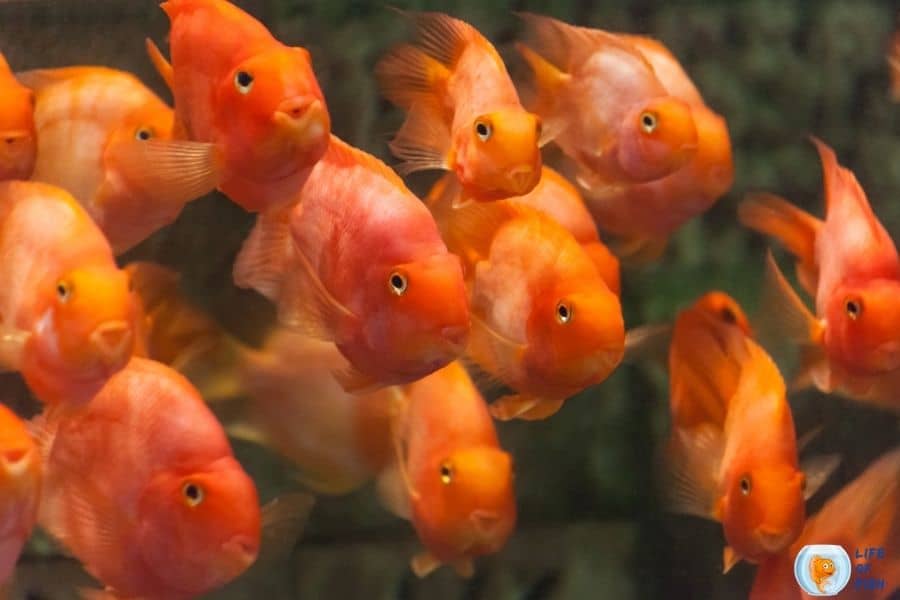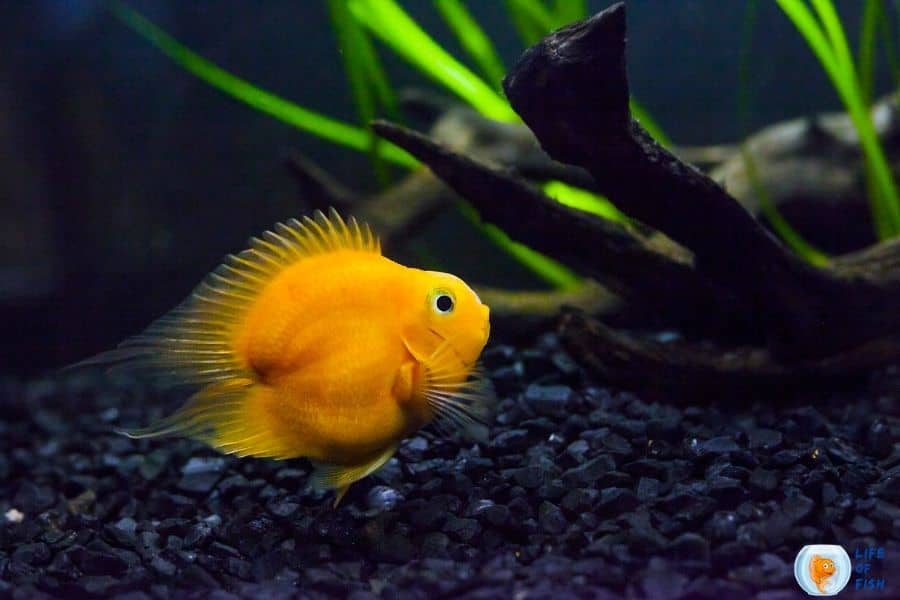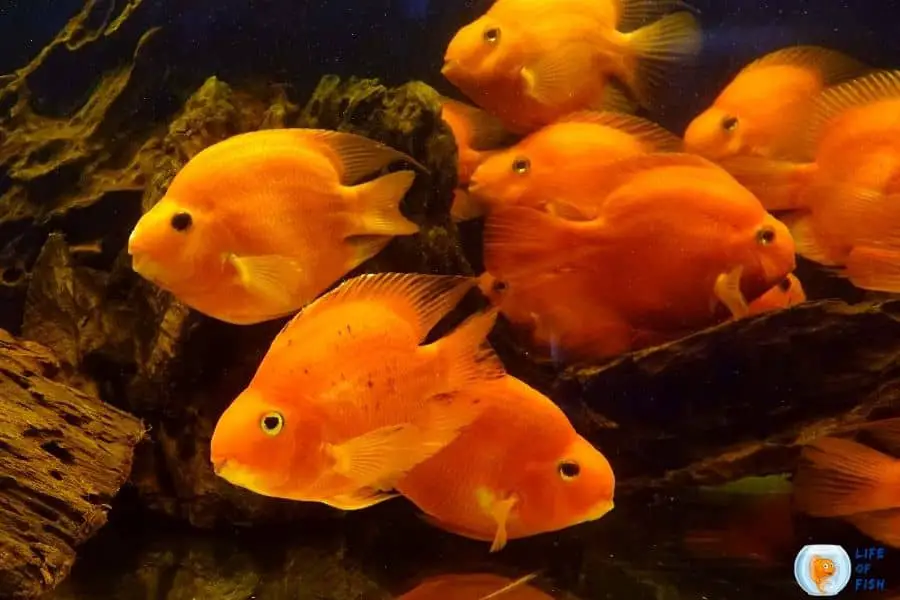Blood parrot cichlid is a cross-bred cichlid species and may not find these fish in the wild anywhere. only their original breeders know how to do the blood parrot cichlid breeding successfully.
Blood parrot cichlids were first introduced to the market back in 1986 in Taiwan.
This type of fish is a hybrid between two different cichlid species, Midas and Golden Severum. Some believe it is a cross between Midas and the Red Devil, but the true parent species is not confirmed yet.
For those who are interested in this topic, below are some interesting facts and information gathered from various sources.

How do you breed red parrot cichlid?
Jump To
- 1 How do you breed red parrot cichlid?
- 2 Can blood parrot cichlids reproduce?
- 3 Blood parrot breeding behavior
- 4 Breeding blood parrots in aquariums
- 5 How can you tell if a blood parrot cichlid is male or female?
- 6 How to identify pregnant blood parrot cichlid?
- 7 Blood parrot cichlid cross-breeding with other cichlid species
- 8 FAQ
- 9 Conclusion
Blood parrot cichlid or red parrot cichlid is not an easy fish to produce. As we said above, it is a cross-breed between two different cichlid species.
To breed them successfully, you need to understand their nature and character. They are not like the conventional cichlid fish that can be easily reproduced in a community tank, for example.
Although Wikipedia suggests it is a cross between Midas and gold severum cichlid, several other sources indicate it is a cross between several cichlid species.
Experts believe it can be a cross between below cichlid species.
- Midas (Amphilophus citrinellus)
- Severum (Heros efasciatus)
- Redhead (Vieja synspilum)
- Red devil (Amphilophus labiatus)
- Firemouth (Thorichthys meeki)
This hybrid species has one or more characteristics of the above cichlid species, but experts say that it has more Redhead and Midas cichlid characteristics so that it can be a cross between those two species. So, who is right? Only their original breeders know.
The breeding of the original red parrot cichlid is still remaining as a mystery. Therefore, you may not be able to breed these fish correctly at home unless you are one of the original breeders in Taiwan.
Can blood parrot cichlids reproduce?
You may not know that hybrid fish species are mostly sterile. They can not reproduce for the most part. The same is true for Blood parrot cichlids.
It is believed that only ten percent of females of this breed can reproduce naturally. However, they will need to be artificially inseminated by humans or cross-breed with other cichlid species, which is not easy.
All male blood parrots are infertile. It means it is impossible to reproduce pure blood parrots.
You either have to cross-breed the parent species or try cross-breeding females with other cichlid species to get blood parrot offspring.
However, if you cross-breed a blood parrot female with other cichlid species, there is less than a 50% chance to have pure blood parrots. Most of the offspring will be a new hybrid species.
As you see, unfortunately, blood parrot cichlids can not reproduce more blood parrot cichlids.
Blood parrot breeding behavior
Although all male blood parrots are infertile, they do have some breeding behavior.
They will try to mate with any willing female blood parrot. The process is not easy, and it usually doesn’t result in a successful pregnancy.
However, if you have a female blood parrot and a male of another cichlid species, it is more likely to result in successful breeding.
The offspring from the cross-breeding of blood parrot cichlid and other cichlid species will be more fertile than purebred blood parrot cichlid.
Breeding blood parrots in aquariums
While you can not expect successful breeding from a blood parrot pair, they actually breed in rare cases.
In rare cases, some male blood parrots are born fertile. If they are paired with a fertile female, they will reproduce a blood parrot offspring.
The best way to breed the original blood parrot cichlid is to keep it in a secluded tank and feed them a high-protein diet (eg brine shrimp).
Like other cichlid species, blood parrots are egg-laying nest builders. They build a nest on the bottom with the substrate and protect dearly after laying their eggs.
If the eggs turn white after about a day, then you can assure that eggs weren’t fertilized. It means your male blood parrot is sterile.
Once the female fish realize that the eggs are infertile, she eats them. If she keeps protecting them a few days more, you can have hopes in a blood parrot offspring.
But beware, blood parrots breeding cases are extremely rare. So, please document your fish and offspring for the world to see.
How can you tell if a blood parrot cichlid is male or female?
Male blood parrot cichlids are usually thinner but larger-bodied than females, and they are more brightly colored.
The male blood parrot’s dorsal and anal fins are more pointed, bigger, and brighter than those of the female. Female blood parrots are usually plumper, have a less pointed dorsal fin, and are duller in color.
How to identify pregnant blood parrot cichlid?
The pregnant blood parrot cichlid is usually duller in color and plumper.
However, after the eggs are carried for about two weeks or so, her belly will become more prominent.
The abdomen of the female will become more rounded. She also tends to stay near the bottom, away from other fish in the tank.
If you see your fish is dull after spawning, it only means that she has laid her eggs. The eggs are now fertilized, and they are on their way to becoming a new blood parrot.
But in most cases, blood parrot eggs become infertile because most male blood parrots are sterile.

Blood parrot cichlid cross-breeding with other cichlid species
As we said before, about ten percent of female blood parrot cichlids can produce eggs. A male cichlid of another species can fertilize these eggs.
Please note that cross-breeding of different fish species is not acceptable as it can lead to many defects.
Blood Parrot cichlids, for example, have deformities such as a mouth that typically remains open, teeth that are located deep down the throat, a deformed body shape that made the fish unable to swim correctly, and its beak-like head with large eyes.
Although some aquarists love these cute-looking deformities, some aquarists consider them inhumane.
While some enthusiasts attempt to cross-breed different cichlid species to create new and unique-looking fish, it is important to be aware of the potential health risks associated with these activities.
When blood parrots mate with other cichlids, the resulting offspring are usually more fertile than purebred blood parrots.
This is because blood parrots are a result of cross-breeding between a male and a female of another cichlid species; it is more likely to result in successful breeding.
The offspring from the cross-breeding of blood parrot cichlid and other cichlid species will be more fertile than purebred blood parrot cichlid.
While you can not expect to get 100% of the original blood parrot cichlid, you can still create some interesting-looking fish.
Before cross-breeding two different fish species, make sure that both are compatible with each other.
You should know that not all cichlid species will mate with one another. Also, note that male and female fish may be compatible, but they might not always mate.
Some compatible cichlid species for cross breeding
- Midas (Amphilophus citrinellus)
- Severum (Heros efasciatus)
- Redhead (Vieja synspilum)
- Red devil (Amphilophus labiatus)
- Firemouth (Thorichthys meeki)
However, there are some things to consider before cross-breeding blood parrot cichlid.
As blood parrot cichlids are genetically mutated, they are not as aggressive as pure breed cichlids. Therefore, most of the time, male cichlid will try to bully the female blood parrot to death.
This happens mostly with the red devil and Midas cichlids. However, blood parrots readily spawn with severum, convict, and Midas cichlids.
So, if you observe bullying behavior from your male fish, then that pair is not compatible.
Cons of hybridization
Although blood parrot cichlid is a great-looking fish that is loved by everyone, not all hybrids look great.
Many hybridized fish just look ugly. This is because the genes of two different species do not always mix well.
When you cross-breed two fish, you also introduce new genes into the bloodline. Some of these genes may be beneficial, but others may not.
Also, when you cross-breed two different fish, you increase the chances of getting defective offspring. This is because the genetic mutation of the blood parrot cichlid is already present.
What should you do?
If your fish cannot mate, then that is not your fault. You can still give them a better life by buying another male and introducing it into their tank.
That way, they will have someone to play with and perhaps mate with. Just make sure that these two fish are compatible.
Although this is a rare mutation, with the proper care and keeping conditions, Blood parrot cichlids can live up to 15 years.
It is important to note that, like other cichlids, they are very territorial and should only be housed with other fish of similar size and non-aggressive.
Cross-breeding blood parrot fish with other cichlids can result in some interesting-looking fish, but it is essential to be aware of the potential health risks associated with these activities.
Before cross-breeding two different fish species, make sure that both are compatible with each other. You should know that not all cichlid species will mate with one another.
And, male and female fish may be compatible, but they might not always mate. But there are many other reasons not to cross-breed fish than doing so. So, we advise you not to cross-breed fish.

FAQ
Can blood parrot cichlid live alone?
Blood parrot cichlids are schooling fish. Although they can live alone, it’s best if you keep them in groups. It will make them more active, and they’ll be happier.
How big should a tank be for blood parrot cichlid?
Cichlids are very territorial. Remember that an adult can grow up to 8 inches long, so the tank should be at least 30 gallons. However, if you’re keeping them with other cichlid species, then the tank size should be much bigger.
What is the lifespan of blood parrot cichlid?
Blood parrot fish can live up to 15 years if properly taken care of. Males tend to have a shorter lifespan than females.
Conclusion
Blood parrot cichlids males are infertile from birth while females are fertile. Therefore, it is impossible to reproduce blood parrots in the home aquaria.
To produce blood parrots, you must cross-breed its parent species, which is still a mystery to the world.
However, you can cross-breed blood parrot females with other selected cichlid species, but the results can be unpredictable and sometimes ugly.
So, if you are not sure about the results, then it is best not to cross-breed your fish.
Read Next : Blood Parrot Cichlid Food | 9 Important Facts About Their Feeding Habits | Blood Parrot Cichlid Tank Mates | 10 Suitable Fish You Must Know | Blood Parrot Cichlid Size | 11 Facts About This Mystery And Abnormal Fish | Blood Parrot Cichlid Tank Size | 13 Less Known But Important Facts |
